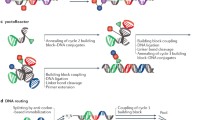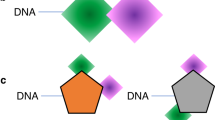Abstract
Careful selection and manipulation of small molecule building blocks is crucial to the success of a DNA-encoded library. Building block selection impacts the quality of the hits arising out of a selection assay, while proper sample handling and tracking ensure follow-up synthetic work is done with the appropriate synthetic map in mind. In this chapter, possible strategies for building block selection are outlined, as well as best practices for handling and tracking samples to be used for validation and library synthesis.
Access this chapter
Tax calculation will be finalised at checkout
Purchases are for personal use only
Similar content being viewed by others
References
Clark MA, Acharya RA, Arico-Muendel CC, Belyanskaya SL, Benjamin DR, Carlson NR et al (2009) Design, synthesis and selection of DNA-encoded small-molecule libraries. Nat Chem Biol 5(9):647–654. https://doi.org/10.1038/nchembio.211
Deng H, Zhou J, Sundersingh FS, Summerfield J, Somers D, Messer JA et al (2015) Discovery, SAR, and X-ray binding mode study of BCATm inhibitors from a novel DNA-encoded library. ACS Med Chem Lett 6(8):919–924. https://doi.org/10.1021/acsmedchemlett.5b00179
Litovchick A, Dumelin CE, Habeshian S, Gikunju D, Guié MA, Centrella P et al (2015) Encoded library synthesis using chemical ligation and the discovery of sEH inhibitors from a 334-million member library. Sci Rep 5:10916. https://doi.org/10.1038/srep10916
Kollmann CS, Bai X, Tsai CH, Yang H, Lind KE, Skinner SR et al (2014) Application of encoded library technology (ELT) to a protein-protein interaction target: discovery of a potent class of integrin lymphocyte function-associated antigen 1 (LFA-1) antagonists. Bioorg Med Chem 22(7):2353–2365. https://doi.org/10.1016/j.bmc.2014.01.050
Harris PA, King BW, Bandyopadhyay D, Berger SB, Campobasso N, Capriotti CA et al (2016) DNA-encoded library screening Identifies Benzo[b][1,4]oxazepin-4-ones as highly potent and monoselective receptor interacting Protein 1 Kinase inhibitors. J Med Chem 59(5):2163–2178. https://doi.org/10.1021/acs.jmedchem.5b01898
Deng H, O’Keefe H, Davie CP, Lind KE, Acharya RA, Franklin GJ et al (2012) Discovery of highly potent and selective small molecule ADAMTS-5 inhibitors that inhibit human cartilage degradation via encoded library technology (ELT). J Med Chem 55(16):7061–7079. https://doi.org/10.1021/jm300449x
Zhu Z, Shaginian A, Grady LC, O’Keeffe T, Shi XE, Davie CP et al (2018) Design and application of a DNA-encoded macrocyclic peptide library. ACS Chem Biol 13(1):53–59. https://doi.org/10.1021/acschembio.7b00852
Eidam O, Satz AL (2016) Analysis of the productivity of DNA encoded libraries. MedChemComm 7(7):1323–1331. https://doi.org/10.1039/c6md00221h
Satz AL, Hochstrasser R, Petersen AC (2017) Analysis of current DNA encoded library screening data indicates higher false negative rates for numerically larger libraries. ACS Comb Sci 19(4):234–238. https://doi.org/10.1021/acscombsci.7b00023
Kalliokoski T (2015) Price-focused analysis of commercially available building blocks for combinatorial library synthesis. ACS Comb Sci 17(10):600–607. https://doi.org/10.1021/acscombsci.5b00063
Walters WP, Stahl MT, Murcko MA (1998) Virtual screening—an overview. Drug Discov Today 3(4):160–178. https://doi.org/10.1016/S1359-6446(97)01163-X
Leach AR, Bradshaw J, Green DV, Hann MM, Delany JJ 3rd. (1999) Implementation of a system for reagent selection and library enumeration, profiling, and design. J Chem Inf Comput Sci 39(6):1161–1172
Benigni R, Bossa C (2006) Structural alerts of mutagens and carcinogens. Curr Comput Aided Drug Des 2(2):169–176
Hale PS (2014) Screening large compound collections. In: Goodnow RA (ed) A handbook for DNA-encoded chemistry. Wiley, Hoboken, pp 281–317
Satz AL (2014) Foundations of a DNA-Encoded Library (DEL). In: Goodnow RA (ed) A handbook for DNA-encoded chemistry. Wiley, Hoboken, pp 99–121
Lipinski CA, Lombardo F, Dominy BW, Feeney PJ (1997) Experimental and computational approaches to estimate solubility and permeability in drug discovery and development settings. Adv Drug Deliv Rev 23(1):3–25. https://doi.org/10.1016/S0169-409X(96)00423-1
Gillet VJ, Willett P, Bradshaw J, Green DVS (1999) Selecting combinatorial libraries to optimize diversity and physical properties. J Chem Inf Comput Sci 39(1):169–177. https://doi.org/10.1021/ci980332b
Sadowski J, Kubinyi H (1998) A scoring scheme for discriminating between drugs and nondrugs. J Med Chem 41(18):3325–3329. https://doi.org/10.1021/jm9706776
Oprea TI (2000) Property distribution of drug-related chemical databases. J Comput Aided Mol Des 14(3):251–264
Hann MM, Oprea TI (2004) Pursuing the leadlikeness concept in pharmaceutical research. Curr Opin Chem Biol 8(3):255–263. https://doi.org/10.1016/j.cbpa.2004.04.003
Hann MM, Leach AR, Harper G (2001) Molecular complexity and its impact on the probability of finding leads for drug discovery. J Chem Inf Comput Sci 41(3):856–864
Teague SJ, Davis AM, Leeson PD, Oprea T (1999) The design of leadlike combinatorial libraries. Angew Chem Int Ed 38(24):3743–3748. https://doi.org/10.1002/(SICI)1521-3773(19991216)38:24<3743::AID-ANIE3743>3.0.CO;2-U
Tomizawa K, Sugano K, Yamada H, Horii I (2006) Physicochemical and cell-based approach for early screening of phospholipidosis-inducing potential. J Toxicol Sci 31(4):315–324
Waring MJ, Johnstone C (2007) A quantitative assessment of hERG liability as a function of lipophilicity. Bioorg Med Chem Lett 17(6):1759–1764. https://doi.org/10.1016/j.bmcl.2006.12.061
Waring MJ (2009) Defining optimum lipophilicity and molecular weight ranges for drug candidates-molecular weight dependent lower logD limits based on permeability. Bioorg Med Chem Lett 19(10):2844–2851. https://doi.org/10.1016/j.bmcl.2009.03.109
Gleeson MP, Hersey A, Montanari D, Overington J (2011) Probing the links between in vitro potency, ADMET and physicochemical parameters. Nat Rev Drug Discov 10:197. https://doi.org/10.1038/nrd3367
Peters JU, Schnider P, Mattei P, Kansy M (2009) Pharmacological promiscuity: dependence on compound properties and target specificity in a set of recent Roche compounds. ChemMedChem 4(4):680–686. https://doi.org/10.1002/cmdc.200800411
Waring MJ, Arrowsmith J, Leach AR, Leeson PD, Mandrell S, Owen RM et al (2015) An analysis of the attrition of drug candidates from four major pharmaceutical companies. Nat Rev Drug Discov 14:475. https://doi.org/10.1038/nrd4609
Bemis GW, Murcko MA (1996) The properties of known drugs. 1. Molecular frameworks. J Med Chem 39(15):2887–2893. https://doi.org/10.1021/jm9602928
Rogers D, Hahn M (2010) Extended-connectivity fingerprints. J Chem Inf Model 50(5):742–754. https://doi.org/10.1021/ci100050t
Acknowledgments
The authors gratefully acknowledge Darren Green, Chris Davie, and Yun Ding for their feedback in review of this chapter.
Author information
Authors and Affiliations
Corresponding author
Editor information
Editors and Affiliations
Rights and permissions
Copyright information
© 2022 Springer Science+Business Media, LLC, part of Springer Nature
About this protocol
Cite this protocol
Billings, K.J., Grenier-Davies, M.C. (2022). Library Synthesis: Building Block Selection, Handling, and Tracking. In: Israel, D., Ding, Y. (eds) DNA-Encoded Chemical Libraries. Methods in Molecular Biology, vol 2541. Humana, New York, NY. https://doi.org/10.1007/978-1-0716-2545-3_1
Download citation
DOI: https://doi.org/10.1007/978-1-0716-2545-3_1
Published:
Publisher Name: Humana, New York, NY
Print ISBN: 978-1-0716-2544-6
Online ISBN: 978-1-0716-2545-3
eBook Packages: Springer Protocols




